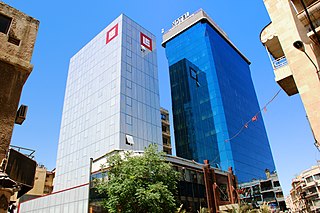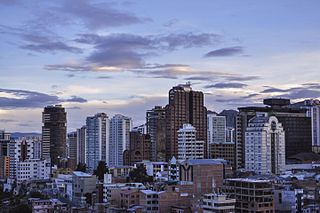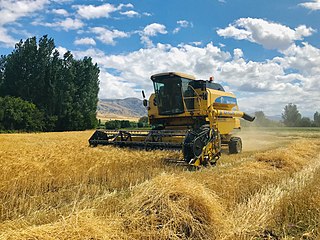
The economy of Armenia grew by 12.6% in 2022, according to the country's Statistical Committee and the International Monetary Fund. Total output amounted to 8.5 trillion Armenian drams, or $19.5 billion. At the same time, Armenia's foreign trade turnover significantly accelerated in growth from 17.7% in 2021 to 68.6% in 2022. GDP contracted sharply in 2020 by 7.2%, mainly due to the COVID-19 recession and the war against Azerbaijan. In contrast it grew by 7.6 per cent in 2019, the largest recorded growth since 2007, while between 2012 and 2018 GDP grew 40.7%, and key banking indicators like assets and credit exposures almost doubled.

The economy of Costa Rica has been very stable for some years now, with continuing growth in the GDP and moderate inflation, though with a high unemployment rate: 11.49% in 2019. Costa Rica's economy emerged from recession in 1997 and has shown strong aggregate growth since then. The estimated GDP for 2023 is US$90 billion, up significantly from the US$52.6 billion in 2015 while the estimated 2024 per capita is US$28,558.

Denmark is a modern high-income and highly developed mixed economy, dominated by the service sector with 80% of all jobs; about 11% of employees work in manufacturing and 2% in agriculture. The nominal Gross National Income per capita was the ninth-highest in the world at $68,827 in 2023.

The economy of Grenada is largely tourism-based, small, and open economy. Over the past two decades, the main thrust of Grenada's economy has shifted from agriculture to services, with tourism serving as the leading foreign currency earning sector. The country's principal export crops are the spices nutmeg and mace. Other crops for export include cocoa, citrus fruits, bananas, cloves, and cinnamon. Manufacturing industries in Grenada operate mostly on a small scale, including production of beverages and other foodstuffs, textiles, and the assembly of electronic components for export.

The economy of Guatemala is a considered a developing economy, highly dependent on agriculture, particularly on traditional crops such as coffee, sugar, and bananas. Guatemala's GDP per capita is roughly one-third of Brazil's. The Guatemalan economy is the largest in Central America. It grew 3.3 percent on average from 2015 to 2018. However, Guatemala remains one of the poorest countries in Latin America and the Caribbean, having highly unequal incomes and chronically malnourished children. The country is beset by political insecurity, and lacks skilled workers and infrastructure. It depends on remittances for nearly one-tenth of the GDP.

The economy of Honduras is based mostly on agriculture, which accounts for 14% of its gross domestic product (GDP) in 2013. The country's leading export is coffee (US$340 million), which accounted for 22% of the total Honduran export revenues. Bananas, formerly the country's second-largest export until being virtually wiped out by 1998's Hurricane Mitch, recovered in 2000 to 57% of pre-Mitch levels. Cultivated shrimp is another important export sector. Since the late 1970s, towns in the north began industrial production through maquiladoras, especially in San Pedro Sula and Puerto Cortés.

The economy of North Macedonia has become more liberalized, with an improved business environment, since its independence from Yugoslavia in 1991, which deprived the country of its key protected markets and the large transfer payments from Belgrade. Prior to independence, North Macedonia was Yugoslavia's poorest republic. An absence of infrastructure, United Nations sanctions on its largest market, and a Greek economic embargo hindered economic growth until 1996.

The economy of Moldova is an emerging upper-middle income economy, Moldova is a landlocked Eastern European country, bordered by Ukraine on the East and Romania to the West. It is a former Soviet republic and today a candidate member to the European Union.

The economy of Poland is an emerging and developing, high-income, industrialized, mixed economy that serves as the sixth-largest in the European Union by nominal GDP and fifth-largest by GDP (PPP). Poland boasts the extensive public services characteristic of most developed economies and is one of few countries in Europe to provide no tuition fees for undergraduate and postgraduate education and with universal public healthcare that is free at a point of use. Since 1988, Poland has pursued a policy of economic liberalisation but retained an advanced public welfare system. It ranks 20th worldwide in terms of GDP (PPP), 21st in terms of GDP (nominal), and 21st in the 2023 Economic Complexity Index. Among OECD nations, Poland has a highly efficient and strong social security system; social expenditure stood at roughly 22.7% of GDP.

The economy of Slovakia is based upon Slovakia becoming an EU member state in 2004, and adopting the euro at the beginning of 2009. Its capital, Bratislava, is the largest financial centre in Slovakia. As of Q1 2018, the unemployment rate was 5.72%.

Syria's economic situation has been turbulent and their economy has deteriorated considerably since the beginning of the Syrian civil war, which erupted in March 2011.

Turkey is a founding member of the OECD and G20. The country's economy ranked as the 17th-largest in the world and 7th-largest in Europe by nominal GDP in 2024. It also ranked as the 12th-largest in the world and 5th-largest in Europe by PPP in 2024. The economy of Turkey is an emerging market, upper-middle income, mixed economy. Turkey has often been defined as a newly industrialized country since the turn of the 21st century.

The economy of Bolivia is the 95th-largest in the world in nominal terms and the 87th-largest in purchasing power parity. Bolivia is classified by the World Bank to be a lower middle income country. With a Human Development Index of 0.703, it is ranked 114th. Driven largely by its natural resources, Bolivia has become a region leader in measures of economic growth, fiscal stability and foreign reserves, although it remains a historically poor country. The Bolivian economy has had a historic single-commodity focus. From silver to tin to coca, Bolivia has enjoyed only occasional periods of economic diversification. Political instability and difficult topography have constrained efforts to modernize the agricultural sector. Similarly, relatively low population growth coupled with low life expectancy has kept the labor supply in flux and prevented industries from flourishing. Rampant inflation and corruption previously created development challenges, but in the early twenty-first century the fundamentals of its economy showed unexpected improvement, leading Moody's Investors Service to upgrade Bolivia's economic rating in 2010 from B2 to B1. The mining industry, especially the extraction of natural gas and zinc, currently dominates Bolivia's export economy.

The economy of the Gambia is heavily reliant on agriculture. The Gambia has no significant mineral or other natural resources, and has a limited agricultural base. About 75% of the population depends on crops and livestock for its livelihood. Small-scale manufacturing activity features the processing of peanuts, fish, and animal hides.

The economy of India is a developing mixed economy with a notable public sector in strategic sectors. It is the world's fifth-largest economy by nominal GDP and the third-largest by purchasing power parity (PPP); on a per capita income basis, India ranked 141th by GDP (nominal) and 125th by GDP (PPP). From independence in 1947 until 1991, successive governments followed the Soviet model and promoted protectionist economic policies, with extensive Sovietization, state intervention, demand-side economics, natural resources, bureaucrat-driven enterprises and economic regulation. This is characterised as dirigism, in the form of the Licence Raj. The end of the Cold War and an acute balance of payments crisis in 1991 led to the adoption of a broad economic liberalisation in India and indicative planning. India has about 1,900 public sector companies, with the Indian state having complete control and ownership of railways and highways. The Indian government has major control over banking, insurance, farming, fertilizers and chemicals, airports, defense, essential utilities, and the energy sector. The state also exerts substantial control over digitalization, broadband as national infrastructure, telecommunication, supercomputing, space, port and shipping industries, which were effectively nationalised in the mid-1950s but has seen the emergence of key corporate players.

Agriculture is still an important sector of Turkey's economy, and the country is one of the world's top ten agricultural producers. Wheat, sugar beet, milk, poultry, cotton, vegetables and fruit are major products; and Turkey is the world's largest grower of hazelnuts, apricots, and oregano.

The economy of Argentina is the second-largest national economy in South America, behind Brazil. Argentina is a developing country with a highly literate population, an export-oriented agricultural sector, and a diversified industrial base.
Bangladesh is an under-developed nation. Despite rapid economic growth, poverty remains a major issue. However, poverty has declined sharply in recent history. Shortly after its independence, approximately 90% of the population lived under the poverty line. However, since economic reforms and trade liberalization of early 1990s, along with accelerated economic growth since early-2000s, Bangladesh have experienced a dramatic progress in reducing poverty. The remarkable progress in poverty alleviation has been recognized by international institutions. According to World Bank, more than 33 million Bangladeshi people have been lifted out of poverty since 2000; as measured by the percentage of people living on the equivalent of US$1.90 or less per day in 2011 purchasing price parity terms.

In 2023, official government statistics reported that the Philippines had a poverty rate of 15.5%,, significantly lower than the 49.2 percent recorded in 1985 through years of government poverty reduction efforts. From 2018 to 2021, an estimated 2.3 million Filipinos fell into poverty amid the economic recession caused by the COVID-19 pandemic.
Tajikistan did not join in the World Bank until 1993. Before the collapse of USSR in 1991, Tajikistan was experiencing planned economy which was dominated by Moscow. Right after the dissolution, different from other nations which experienced a relatively stable transition from planned economy to market economy, Tajikistan fell into a serious civil war. As a result, the first mission after Tajikistan became the official member of the World Bank, was to recover its economy from bullets and blood. In 1997. $10 million credit was grant for Post-Conflict Rehabilitation Project. The proposed credit was used to conduct necessary imports and to restore production. Under different time periods, the World Bank and Tajikistan worked together in response to various problems. Later on, the economic crisis of 2008 caused the inflation of food prices in Tajikistan. In response to the crisis, the World Bank issued $6.25 million for the Emergency Food Security and Seed Imports Project in order to help at least 28000 households to release the food price pressure. Coming into the 21st century, Tajikistan received financing from IDA and IBRD of the World Bank with respect to programs of healthcare, education, irrigation and agriculture. Over the past years, Tajikistan has received over 130 projects of which 17 are active and a total of over $1.4 billion from the World Bank. With the help of those projects, from 2000 to 2017, the poverty rate in Tajikistan had been decreased from 83% to 29.5%. Besides, current GDP growth rate in Tajikistan is around 7%. Nevertheless, with a stable GDP growth rate, Tajikistan is still one of the poorest countries in Central Asia.


















